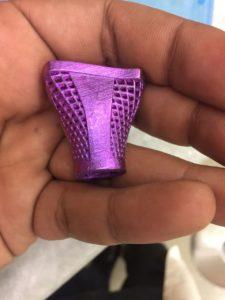Most people know tuberculosis as a disease of the lungs, but that’s not always the case. For a 32-year-old woman in India, the disease manifested in her spine – in 10 different vertebrae, thanks to a lowered immune system caused by drugs she was taking for infertility. Her condition deteriorated quickly; the disease caused such extensive damage to her first, second and third cervical vertebrae that she no longer had any support between her skull and lower spine.
As a result, the woman’s head was sliding forward and her posture curved in a way that obstructed her spinal cord, resulting in progressive weakness in her limbs. She was also at risk of quadriplegia and even death, if her respiratory nerves were to become compressed. If you’re shuddering at this point, you’re not alone, but this young woman is going to be just fine, as impossible as that sounds.
Surgeons at Medanta – The Medicity in Gurgaon, India, replaced the woman’s damaged first, second and third vertebrae with a 3D printed titanium implant in a 10-hour surgery, closing the gap between her skull and spine and allowing her to stand and walk normally again. It was the first time such a procedure had been performed in India, and among the first in the world, following similar operations in China that first took place in 2014 and a surgery that was performed a year ago in Australia.
“Given the complexity of this case, the use of 3D-printing technology has helped us in bringing a successful outcome,” said Dr. V Anand Naik, Senior Consultant (Spine Surgery) at Medanta’s Bone & Joint Institute. Dr. Naik led the surgical team that operated on the woman. “The patient today on 12 post-operative days is now walking with minimal support, all her pain has gone, her voice and dysphasia has recovered completely and, most importantly, her life was saved by this technique.”
Sanjay Kumar Pathak of Global Health Care in New Delhi told 3DPrint.com that the titanium implant, customized to perfectly fit the patient’s spine, was designed at his company and then printed at a medical service bureau using a machine from SLM Solutions. CT and MRI scans were used to 3D print a replica of the woman’s spine so that the gaps between her vertebrae could be measured to ensure that the final printed vertebra would fit perfectly. The 3D printed implant was tested for biomechanics and stress risers, with input from multiple design teams in India, the US and Sweden, before Global Health Care provided the final version to the hospital for implantation.
The patient, a teacher, is recovering quickly and is expected to be able to return to a normal, independent life without risk in about two weeks – incredible considering the severity of her condition before the surgery. Just a few years ago, there would have been very little hope for her, but 3D printing is changing the prognosis of many, many severely ill and injured patients from dire to bright.
“These techniques have opened a new avenue wherein any type of complex reconstruction can be done in the spine with less collateral damages,” said Dr. Naik.
Discuss in the 3D Printed Vertebrae forum at 3DPB.com.
Subscribe to Our Email Newsletter
Stay up-to-date on all the latest news from the 3D printing industry and receive information and offers from third party vendors.
Print Services
Upload your 3D Models and get them printed quickly and efficiently.
You May Also Like
3D Printing News Briefs, July 2, 2025: Copper Alloys, Defense Manufacturing, & More
We’re starting off with metals in today’s 3D Printing News Briefs, as Farsoon has unveiled a large-scale AM solution for copper alloys, and Meltio used its wire-laser metal solution to...
3DPOD 260: John Hart on VulcanForms, MIT, Desktop Metal and More
John Hart is a Professor at MIT; he´s also the director of the Laboratory for Manufacturing and Productivity as well as the director of the Center for Advanced Production Technologies....
3D Printing News Briefs, June 28, 2025: Defense Accelerator, Surgical Models, & More
In this weekend’s 3D Printing News Briefs, 3YOURMIND was selected to join an EU Defense Accelerator, and PTC has announced model-based definition (MBD) capabilities within Onshape. Finally, a study out...
EOS in India: AM’s Rising Star
EOS is doubling down on India. With a growing base of aerospace startups, new government policies, and a massive engineering workforce, India is quickly becoming one of the most important...









































